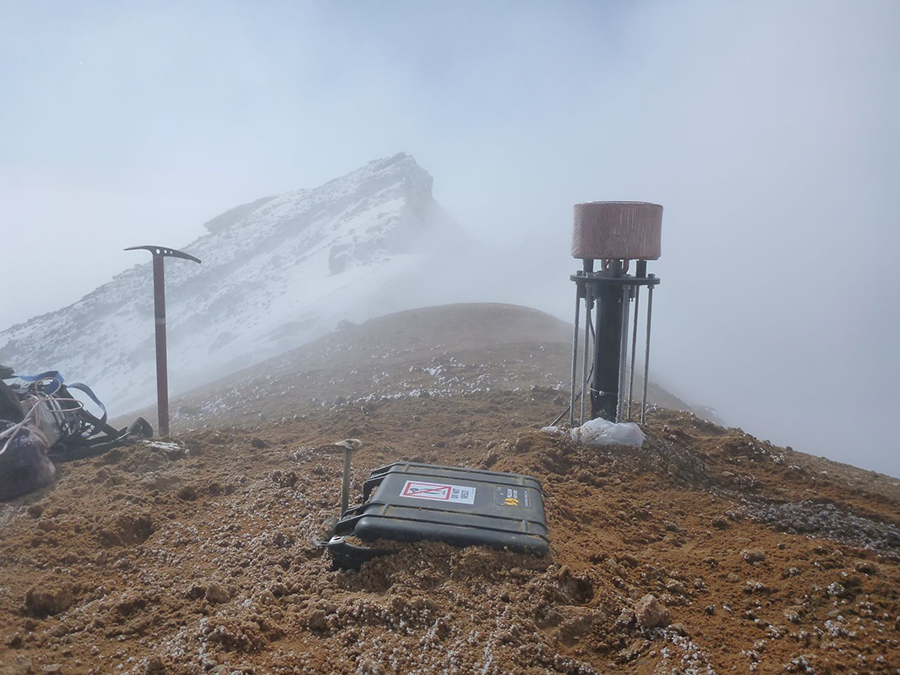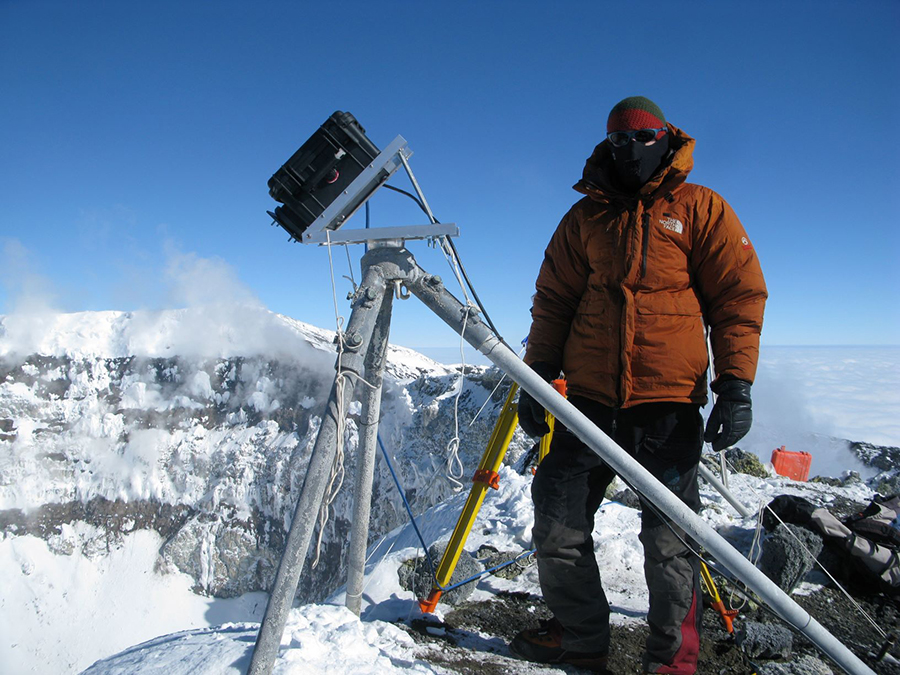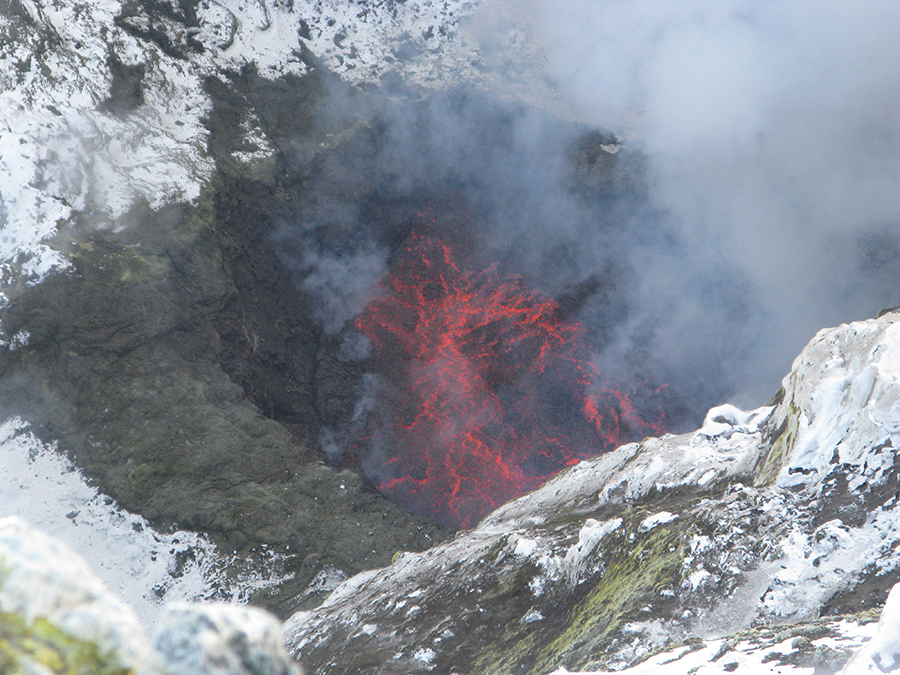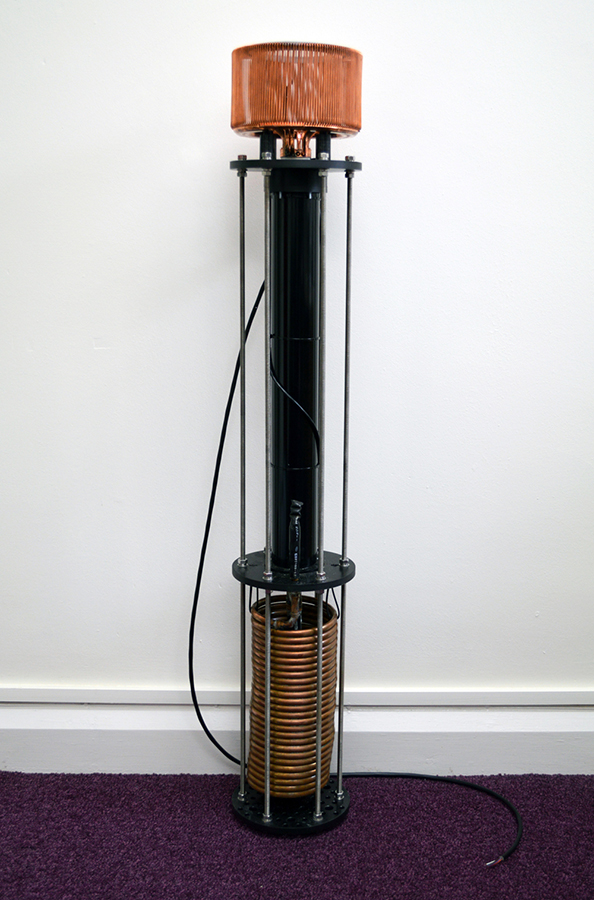Tapping Erebus's powerPowering instruments with heat from the volcano could help scientists observe its lava lake year-roundPosted July 26, 2021
The heat given off by Antarctica’s Mount Erebus could help power instruments monitoring the volcano, giving scientists a way to study Erebus’s lava lake during the long polar night for the first time. 
Photo Credit: Nial Peters
The prototype thermal generator installed at Mt. Erebus. Part of the instrument sits below grade to pull heat from the ground.
Researchers have found a way to harness the heat from the magma underneath Erebus and turn it into electricity that can power scientific instruments. They’ve developed a prototype generator that pulls heat from the ground at the volcano’s summit and provides just enough energy to keep batteries alive during the long, cold Antarctic winter. The prototype produces a tiny amount of energy – less than a smartphone flashlight – but it’s enough to fuel low-powered volcanic sensors. An array of generators like this could keep more power-intensive equipment running throughout the winter, allowing scientists to monitor the volcano’s open lava lake year-round – something that has never been possible at Erebus before. The technology could be used at other Antarctic volcanoes and be applied to other types of scientific instruments that require little power, according to the researchers. “It’s quite a cool piece of technology that's fun to use,” said Nial Peters, an engineer at University College London and lead author of a recent study describing the prototype generator. “It doesn't solve all of your power problems for monitoring volcanoes, but it certainly has potential to be a very useful tool.” A unique laboratoryErebus is the most active volcano in Antarctica and the southernmost active volcano on Earth. It’s a unique natural laboratory for studying volcanoes because there’s an open lava lake at its summit, one of only a handful on Earth. 
Photo Credit: Clive Oppenheimer
Nial Peters behind the thermal camera set up to take infrared images of Erebus’s lava lake. Peters hoped the prototype generator he installed would help power the camera during the long polar night.
Lava lakes are rare enough, but Erebus’s lava lake is even more intriguing because it’s been around for so long. Scientists discovered the lake in the early 1970s, but early Antarctic expeditioners noticed Erebus had a red glow around its summit. This suggests the lava lake has been there since at least the early 1900s, said Philip Kyle, professor emeritus at the New Mexico Institute of Mining and Technology and co-author of the new study. “It's very unusual to have this long-lived feature,” Kyle said. “What we're seeing is what's really going on inside a volcano.” Scientists deploy a myriad of equipment around a volcano to study what’s going on inside. Seismic sensors pick up any ground shaking in the vicinity, instruments measure gases rising out of the crater, and thermal cameras pick up heat from flowing magma, to name a few. And volcanologists rely on these instruments to take continuous measurements when they’re not around. “You want to have year-round 24-hour surveillance to keep your finger on the pulse of what the volcano is up to – how often is it erupting, do we see a change in patterns, and things like that,” Kyle said. But powering these instruments can be challenging. Typically they’re fueled by solar panels, batteries, and wind turbines. But in Antarctica, solar panels can’t work during the dark polar night, the extreme cold drains batteries quickly, and violent storms can destroy wind turbines. The instruments tend to work during the summer, but not in the winter, so it’s nearly impossible to monitor Erebus continuously year-round. Besides the weather challenges, Erebus belches puffs of corrosive gas and occasionally spews volcanic bombs – chunks of lava that solidify as they fall – that can easily damage or destroy equipment left on its flanks. Not to mention that scientists can only get to the summit in summer, making it difficult to maintain or repair equipment. “Installing that instrumentation is incredibly hard, and we work very hard to maintain that instrumentation ... but the fundamental issue is power,” Kyle said. Solving the power problemPeters had been studying Erebus’s lava lake since 2009 and wanted to install a thermal camera that could observe the bubbling liquid continuously throughout the year, but his camera was always let down by the power supply. “It never ran completely over the winter,” he said. “As soon as the sun went down, we found that the power would go off shortly afterward.” Peters found a potential way around the power problem while attending a conference where an engineer talked about thermoelectric generators – generators that convert heat into electricity. If there’s a temperature difference, say, between the ground and air, the generator uses that heat flow to create a voltage difference that produces electricity. The technology isn’t new – part of it is used in reverse to cool down computer processors – but it had never been used in this context before. There’s enough hot magma flowing beneath Erebus to keep the Antarctic volcano free of snow in many spots, so Peters suspected there was enough heat on its flanks to power the machine. In fact, when he measured the temperature of the ground at the crater summit, he found it got up to 80 degrees Celsius (176 degrees Fahrenheit). Peters and his colleagues deployed a prototype generator at Erebus’s summit in December 2014 and found that it worked – the heat flow did generate power, albeit on a very small scale. The device produced about a quarter of a watt of power – less than a high-powered laser pointer and much less than he needed to run the thermal camera – but it was producing power continuously. “This was a quarter of a watt continuously, irrespective of whether the sun was up, irrespective of whether the wind was blowing to drive the wind turbine,” Peters said. That tiny trickle of electricity would be enough to keep the thermal camera’s batteries from draining through the winter, and if engineers optimized the design of the generator, it could draw even more power from Erebus, according to Peters. The device likely couldn’t power a thermal camera on its own, but an array of them could be enough to power some monitoring instruments throughout the winter. Infrasound sensors, which listen for rumblings from a volcano too low in frequency for humans to hear, would be a good place to start. “The sensors for those require tiny amounts of power – maybe in the tens of milliwatts,” Peters said. “So this one generator would be able to power an entire array of infrasound sensors.” Not only does this work have implications for studying Erebus, but it also could improve monitoring of other volcanoes in the region, according to Kyle. Mount Rittmann, for example, sits below the flight path of many aircraft that fly from New Zealand to McMurdo Station and could pose a hazard to those aircraft if it erupted. “There are volcanic hazards in Antarctica – that's the bottom line,” he said. This research was supported by the National Science Foundation, which manages the U.S. Antarctic Program. NSF-funded research in this story: Philip Kyle and Clive Oppenheimer, New Mexico Institute of Mining and Technology, Award No. 1142083. |



For USAP Participants |
For The Public |
For Researchers and EducatorsContact UsU.S. National Science FoundationOffice of Polar Programs Geosciences Directorate 2415 Eisenhower Avenue, Suite W7100 Alexandria, VA 22314 Sign up for the NSF Office of Polar Programs newsletter and events. Feedback Form |




